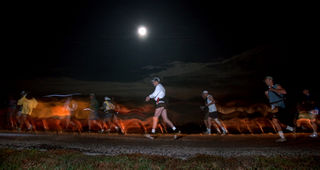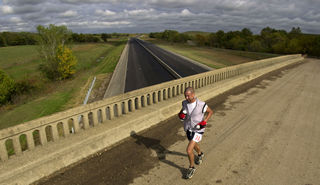CASSODAY, Kan. (AP) _ Beneath the wide Kansas sky, a small band of hardy souls got close to nature, and each other, running across the rolling prairie one fine fall weekend.
Forty-three dedicated runners came to Cassoday -- population 99 -- for the fourth annual Heartland 100-Mile Run. Some came for competition, some came for camaraderie, and some came just for the scenery.
"I love the course," said Jamie Menard, of Denver, who ran the 50-mile race in 2001 and returned this year for the 100-mile, "just the beauty of it."
Runners start at 6 a.m. on Saturday and follow a meandering out-and-back route on gravel roads through remote parts of Butler, Greenwood and Chase counties. They have 30 hours -- until noon Sunday -- to finish.
"I like the loneliness of it," said Dallas Smith, of Cookeville, Tenn., during a brief stop at the wind-swept Ridgeline aid station, 36 miles into the race. "It's the wildest, most primeval thing you can do -- legally," he said.
Smith, 63, completed the race in just over 24 hours in 2002 and returned in 2003. "I wanted to see the tallgrass prairie and the Flint Hills," he said.
The Heartland Run is known as an "easy" 100-mile run.
"It's really ideal for the novice or first-time (100-mile) runner," said race director Randy Albrecht, of Wichita, a member of the Kansas Ultrarunners Society, which sponsors the race.
"Usually about 75 percent finish," he said. "It's got a reputation as an easy course, but it's still 100 miles."
Ultra runs -- races longer than the standard marathon distance of 26.2 miles -- and trail runs, which may be any distance and are often held in difficult terrain, are growing in popularity.
People run them "for the challenge," said Don Allison, editor and publisher of Ultrarunning magazine in Weymouth, Mass. "Many of them have run 5Ks, 10Ks, maybe a road marathon, and they're looking for something that offers more of a test."
That's true not only in scenic mountain areas like Colorado but also in the flatlands of Kansas, where the Kansas Ultrarunners group began with four founding members in 1995.
"There's now an influx of people moving from shorter races to ultras," said Eric Steele, of Wichita, a KUS founder and past president. "A lot of people reach the marathon distance, then realize there's something over and above the marathon."
Starting with a single race in 1995, Kansas Ultrarunners has since grown to about 60 members and sponsors five events a year.
Trail runs and ultra runs draw a different sort of runner than typical big-city marathons and road races.
"They're looking for something that offers more of a test," Allison said.
On the other hand, trail runs and ultras can be less intense.
"Ultras can be easier because you can walk, run or just trot along," he said. "That can appeal to an older person."
Ben Holmes, 46, a KUS member from Lenexa, has been running ultras for about four years.
"Trail running is on all kinds of surfaces and uses many muscle groups," he said. "You may be more tired and exhausted, but you're not going to get overuse injuries and there's less pounding than on pavement."
About 1 a.m. Sunday, a glimmer of light bobbing along a line of trees about a half-mile from the finish turned out to be race winner Mark Henderson.
Henderson, 43, of Pearland, Texas, finished in 18 hours, 41 minutes, to the sound of cowbells clanging as he ran the final quarter-mile and crossed the finish line.
Henderson, who won the 2001 race in 17:17, apologized for not breaking 18 hours.
"That was about the best I could do," he said. "There was a weird cold. The wind kicks up and you freeze, then the wind drops and you sweat.
"But I had fun the whole time. I started at the back and visited with all my friends, then got up to the front. I was just out there having fun. It's kind of a weird way to have fun, isn't it?"
Henderson took a 30-minute break at the Lapland aid station, at the 83-mile point, to eat and to borrow a shirt.
"They fed me bacon, they fed me pancakes, and they gave me the shirt off their back," he said.
Runners pass cows in pastures along the course and hear the occasional coyote, but Henderson said he had never seen any wildlife in his three previous races at Heartland.
This time was different.
"I saw a cougar," he said. "I was complaining about running 300 miles (here) and hadn't seen a bunny. Then a deer came by. Then way back, I saw this thing in the brush right beside the road, looking at me. ... I'm running, and the thing jumps up. I've seen pictures of cougars but never saw a real one before."
Many ultra and trail runners say the people they meet and the places they see are what they like best in their sport.
"I've met some really neat people all around the country," said Dann Fisher, a KUS member and professor of accounting at Kansas State University. "And I get to see things I wouldn't normally -- on trails off the road where I wouldn't go for any other reason."
Holmes said he enjoys the camaraderie among the runners.
"You may be competing against somebody, but you may be running and talking to them for 20 miles," he said. "Other times, you may be alone for 20 miles."
That also represents an advantage for older runners.
"Fifteen years ago I couldn't imagine running by myself for 20 or 30 miles and being alone with my thoughts for that long," Holmes said. "But now I'm comfortable with myself, and I don't mind being alone. I think that's a part of maturity."



